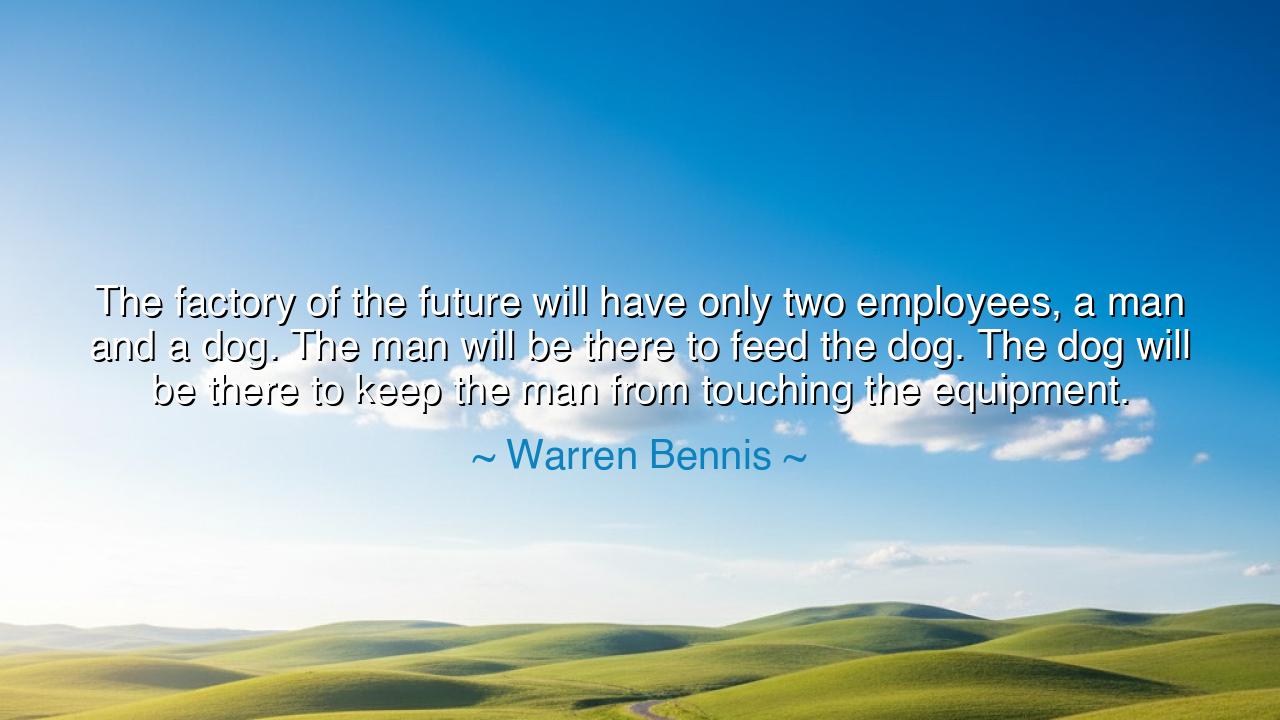
The factory of the future will have only two employees, a man and
The factory of the future will have only two employees, a man and a dog. The man will be there to feed the dog. The dog will be there to keep the man from touching the equipment.






In the vision of Warren Bennis, the future factory is a place where technology has replaced much of the traditional human labor, leaving behind a man and a dog. His words, “The factory of the future will have only two employees, a man and a dog. The man will be there to feed the dog. The dog will be there to keep the man from touching the equipment,” offer a sobering reflection on the rise of automation and the diminishing role of human labor in a rapidly evolving technological landscape. Bennis’s quote is not just a humorous imagining but a warning about the direction in which our world is heading—one where machines do most of the work, and humans are left to either manage or maintain the system, often at a distance.
The ancients were no strangers to contemplating the role of work and technology in their lives. Plato, in his Republic, spoke of the division of labor within an ideal society, where each person has a role that fits their natural ability. However, his vision was one in which human effort was still central to productive labor, unlike the world Bennis imagines, where machines would replace human effort altogether. Plato’s ideal of a just society relied on the belief that work and virtue were interconnected, with each person contributing to the good of the whole. In contrast, Bennis’s vision of a future where machines perform the labor and humans are left with lesser tasks evokes the idea of a disconnect between human purpose and work.
This idea of machines replacing human labor is not entirely foreign to the course of history. The Industrial Revolution marked a time when machines began to replace manual labor, dramatically transforming the lives of workers and the structure of society. Factories emerged as hubs of mechanized work, where human hands were needed less and less. Yet, while the Industrial Revolution brought advancements, it also created a divide between manual laborers and the owners of these machines. Workers were often relegated to menial tasks while the machinery, designed to perform greater tasks, became the dominant force of production. Bennis's quote reflects this modern evolution, where machines not only perform labor but control the very fabric of the workplace, reducing humans to mere overseers of technology.
Bennis’s vision is not merely a commentary on automation but on the relationship between humans and technology. The imagery of a dog in the factory, guarding the machines from the humans, suggests a separation between the workforce and the tools of progress. The dog becomes a symbol of protection—a barrier to human interference in a world where machines are the new masters. This shift toward automation raises critical questions about the future of human purpose and identity in a world increasingly dominated by technology. In this future, as machines handle the tasks that once required human effort, what will be left for humans to do? Will we still find purpose in our work, or will we become merely observers of a world we no longer control?
In modern history, Elon Musk and Steve Jobs are often cited as figures who, through technology, have altered the course of industries and economies. Yet, as these men innovate with automation and artificial intelligence, we must ask: what role will humanity play as we replace so many aspects of work with machines? Musk’s vision of a future Mars colony and the growth of Tesla’s autonomous vehicles point to a world where machines are not only laborers but also innovators. The vision of a future where humans are overseers rather than hands-on workers might be coming to fruition, but it’s essential to ask—what is lost when we no longer use our hands to create, to build, or to produce? What does it mean for a person to find meaning when machines handle the work of the world?
The lesson in Bennis’s words, though evocative of a potential future, urges us to reflect on our current relationship with technology. Are we allowing machines to enrich our lives, or are we, unknowingly, surrendering our humanity in the process? The growing divide between work and life, driven by automation, calls us to consider how we can preserve our purpose in a world that seems to care more for efficiency than for the value of human involvement. As robots and artificial intelligence become more commonplace in the workplace, we must ask ourselves: what do we want our legacy to be? Do we want to be remembered as mere bystanders in the story of progress, or will we find a way to remain central to the creation of a future where humans and technology coexist harmoniously?
In our own lives, we must be vigilant in our engagement with technology. While the promise of automation can bring convenience and progress, we must also remember that meaningful work—the kind that nurtures creativity, purpose, and connection—is not something to be discarded. As Bennis so wisely implies, the future of humanity is not determined solely by machines, but by how we continue to shape our roles within this changing world. Let us hold on to our purpose, finding ways to adapt while ensuring that we do not lose the essence of what it means to be human—to build, create, and find meaning in the work we do, whether it’s with machines or in partnership with them.






AAdministratorAdministrator
Welcome, honored guests. Please leave a comment, we will respond soon